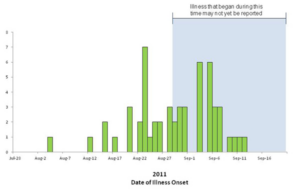Since when did cantaloupe become a WMD*?
Are you as puzzled about the latest cantaloupe outbreak as I am? This time it’s Listeria again (see previous post on this particular pathogen).
According to the CDC, 72 people have been infected with the strains of Listeria associated with the outbreak in 18 states. Most appalling, 13 people have died.
The CDC says that the people who have become ill range from 35 to 96 years, with a median age of 78 years. Most are over age 60 or have health conditions that weaken the immune system. Pregnant women are at especially high risk as are their fetuses.
As always, the recall occurred after most of the cases were reported to the CDC. The cantaloupe were traced to Jensen Farms, which issued a recall on September 14.

Why cantaloupe? They are, after all, grown in dirt and their skin is rough, textured, and has plenty of places for bacteria to hide. People pick up Listeria by handling the fruit and cutting into it. FDA’s information page lists the recalls and press releases on the Jenson Farms outbreak.
The FDA’s advice: throw it out.
Do not try to wash the harmful bacteria off the cantaloupe as contamination may be both on the inside and outside of the cantaloupe. Cutting, slicing and dicing may also transfer harmful bacteria from the fruit’s surface to the fruit’s flesh.
What do food safety experts say you have to go through to avoid getting sick from eating cantaloupe?
- Wash the melon under running water with a clean vegetable brush.
- Blot with paper towels to remove excess water.
- Put melon on a clean surface, one that hasn’t come into contact with meat or poultry or other foods that could cause cross-contamination.
- Cut off the stem end about 3/4 to 1 inch from the end, using a clean kitchen knife.
- Place melon on a clean cutting board, plate, or other clean surface with the cut end facing down.
- Using a clean knife, cut the melon from the blossom end to the stem end.
- Follow this by washing the knife with clean running water and setting it aside.
- Gently scrape out the seeds with a clean spoon and cut the melon into slices or whatever is desired.
- Don’t use dish soap or detergent; cantaloupes can absorb detergent residues.
- Do not allow the rind to touch any part of the edible fruit.
- Melon that isn’t eaten should be peeled, covered and refrigerated.
- Discard any melon that has been at room temperature for longer than 2 hours, or 1 hour when the temperatures are over 90 degrees F.
- Follow these procedures for all melons, no matter where they were grown.
What? No HazMat suit?
We are talking about cantaloupes here.
How about a food safety system where everyone makes sure—and tests—that Listeria don’t get on cantaloupe in the first place.
Single food agency anyone?
_____
*Translation: Weapon of Mass Destruction

